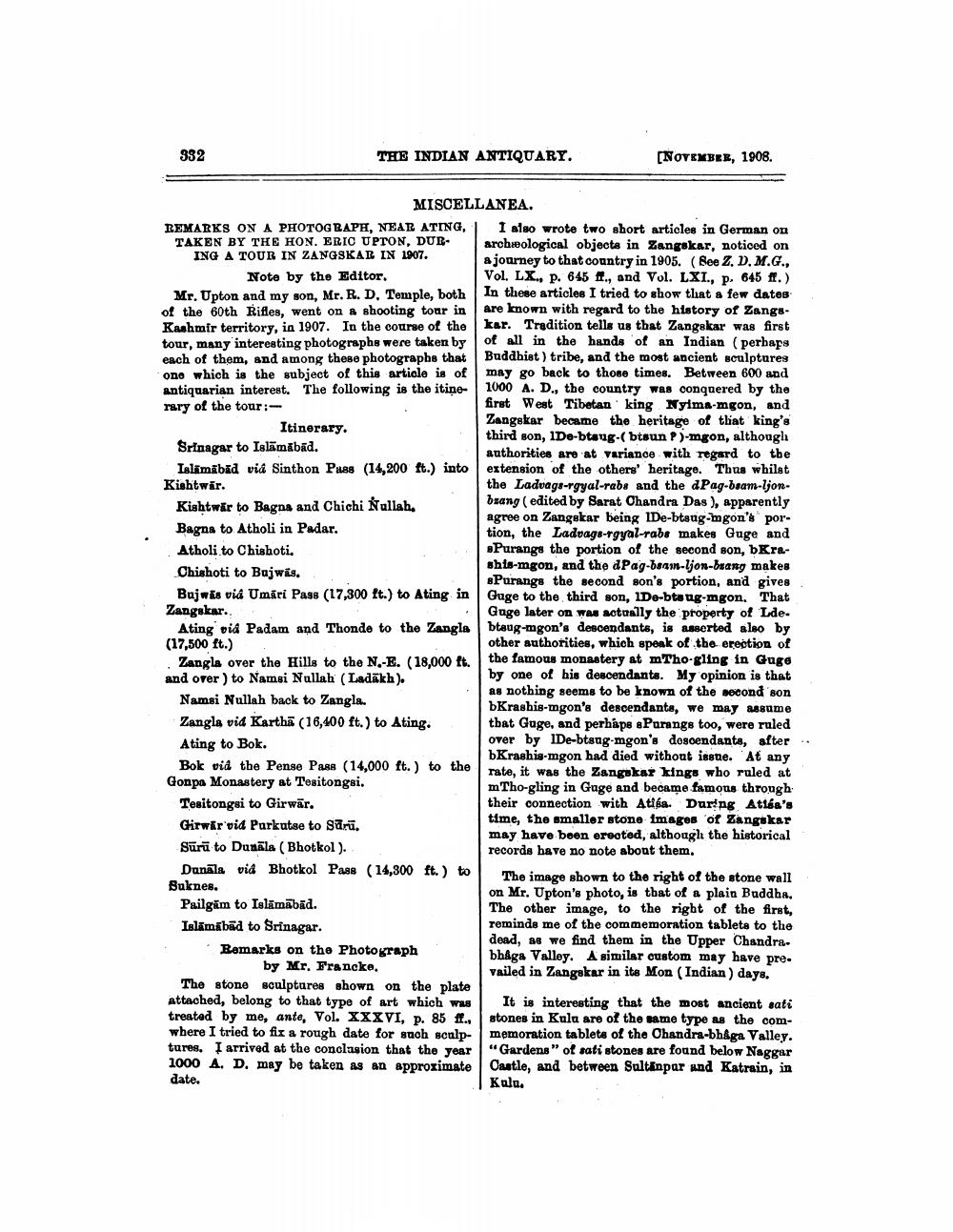________________
332
THE INDIAN ANTIQUARY.
[NOVEMBER, 1908.
MISCELLANEA. REMARKS ON A PHOTOGRAPH, NEAR ATING, I also wrote two short articles in German on TAKEN BY THE HON. ERIC UPTON, DUR- archeological objects in Zangokar, noticed on ING A TOUR IN ZANGSKAR IN 1907. a journey to that country in 1905. (Bee Z.D.M.G., Note by the Editor.
Vol. LX., p. 645 ft., and Vol. LXI., p. 645 ff.) Mr. Upton and my son, Mr. R. D, Temple, both In these articles I tried to show that a few dates of the 60th Rifles, went on & shooting tour in are known with regard to the history of ZangeKashmir territory, in 1907. In the course of the kar. Tradition tells us that Zangekar was first tour, many interesting photographs were taken by of all in the hands of an Indian (perhaps each of them, and among these photographs that Buddhist ) tribe, and the most ancient sculptures ono which is the subject of this article is of may go back to those times. Between 600 and antiquarian interest. The following is the itine- 1000 A. D., the country was conquered by the rary of the tour:
first West Tibetan king Nyima-mgon, and
Zangskar became the heritage of that king's Itinerary
third son, 1De-btang-( btsun P)-mgon, although Srinagar to Islamabad.
authorities are at variance with regard to the Islamabad vid Sinthon Pass (14,200 ft.) into extension of the others' heritage. Thus whilst Kishtwar.
the Ladvags-rgyal-rabs and the dPag-bsam-ljonKishtwir to Bagna and Chichi Nullah. brang ( edited by Sarat Chandra Das), apparently
agree on Zangakar being IDe-bteug-mgon's porBagns to Atholi in Padar.
tion, the Laddags-rgyal-rabs makes Guge and Atholi to Chishoti.
8Purange the portion of the second son, KraChishoti to Bajwis.
shis-mgon, and the dPag-sam-ljon-buang makes
8Purangs the second son's portion, and gives Bujwis via Umari Pass (17,300 ft.) to Ating in Guge to the third son. IDe-btang-mgon. That Zangskar..
Guge later on was actually the property of Lde. Ating vid Padam and Thonde to the Zangla btaug-mgon's descendants, is asserted also by (17,500 ft.)
other authorities, which speak of the erection of Zangla over the Hills to the N.-E. (18,000 ft. the famous monastery at mTho-gling in Guge and over ) to Namsi Nullah (Ladakh).
by one of his descendants. My opinion is that
as nothing seems to be known of the second son Namsi Nullah back to Zangla.
bKrashis-mgon's descendants, we may assume Zangla vid Karthā (16,400 ft.) to Ating. that Gage, and perhaps & Purange too, were ruled Ating to Bok.
over by IDe-btsug-mgon's descendants, after ..
bKrashis-mgon had died without isene. At any Bok vid the Pense Pass (14,000 ft.) to the
rate, it was the Zangokat kings who ruled at Gonpa Monastery at Tesitongsi.
m Tho-gling in Gage and became famous through Tesitongsi to Girwār.
their connection with Atiba. During Atiba's Girwar'vid Parkutse to Sürū.
time, the smaller stone Images of Zangakar
may have been erected, although the historical Sūrā to Dunāla (Bhotkol).
records have no note about them. Danala vid Bhotkol Pass (14,800 ft.) to
The image shown to the right of the stone wall Buknes.
on Mr. Upton's photo, is that of a plain Buddha, Pailgām to Islamabad.
The other image, to the right of the first, Islamabad to Srinagar.
reminds me of the commemoration tablets to the
dead, as we find them in the Upper Chandra. Bemarks on the Photograph
bhAga Valley. A similar custom may have pre. by Mr. Francke.
vailed in Zangskar in its Mon (Indian ) days. The stone sculptures shown on the plate attached, belong to that type of art which was It is interesting that the most ancient sati treated by me, ante, Vol. XXXVI, p. 85 ff., stones in Kulu are of the same type as the comwhere I tried to fix a rough date for such sculp- memoration tablets of the Chandra-bhaga Valley. tures. I arrived at the conclusion that the year “Gardens" of sati stones are found below Naggar 1000 A. D. may be taken as an approximate Castle, and between Saltanpar und Katrain, in date.
Kulu.




